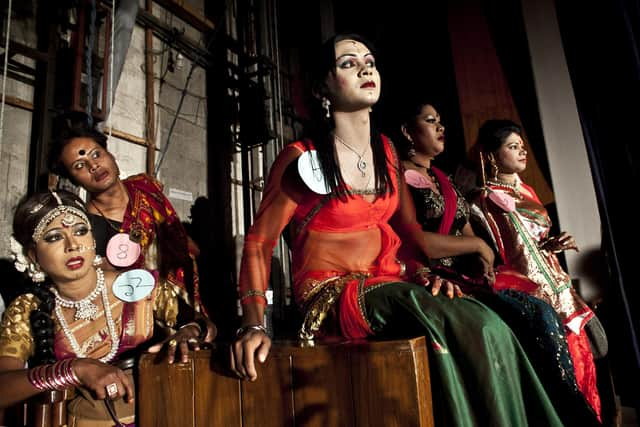Angry Gen Z culture warriors need to learn from other cultures with multiple genders – Kate Copstick
When I was at university, I was fascinated with being neither male not female. I had a penchant for men's three-piece suits and demanded people call me Copstick, rather than Kate. One of my friends was George. George was gay. Borderline hysterical in fact. Once a month, we would all remind one another that “George is on her monthlies” and be a little extra understanding. George was very special to all of us.
Non-binary didn't start with Sam Smith, you know. Inbetweenies have always been with us, historically and culturally. In some cultures, embraced, even revered. And that is a wonderful thing. It is just that, here, now, in the West, Gen Z, the world's first generation of the terminally indulged, has given everyone their own flag, and turned gender identity politics into an indulgent game for a generation in search of a meaning. And it should not be that.
Advertisement
Hide AdAdvertisement
Hide AdEvery generation has its 'thing'. The wrinklies disapprove, the kids rebel. From rock 'n' roll, through the hippy generation and all the free love that went with it, to punk and working-class anger, generations have given identity to their youth and their parents have heartily disapproved. It seems that now, the generations have run out of 'things' and simply disapprove of everything that has gone before.
Spaces between genders
They are concerned with the face value of everything – policing the words we use, announcing that the 'thumbs up' emoji is passive aggressive. They are intent on removing the grit from everyone's oyster and cannot see far enough forward to realise they are creating a world without pearls. And, for me, old and embittered as I am, they are so busy being 'traumatised' by everything, they really have not developed much positive imagination.
Yes, it is a wonderful thing that if a person – of any age – wants to explore the other sides of themselves, they can. Marvellous. To be encouraged. But I find it fascinating, and disappointing, that gender identity here – after all the shouting and “I stand with ...” Facebook posts about non-binary – is still, in actual fact, very binary. All the gender tombola digital wallpaper and the self-identification rights still boil down to males who identify as female and females who identify as male, with various sexual orientations as the icing on the cake/muffin.


I think some of us are more than that. Is it not possible that there is more in the spaces between the genders than our culture allows for? And that more of those who feel uncomfortable – for whatever reason – with the gender they are born to, might feel quite happy there.
I fully realise this is dangerous ground. But we are already there, in many ways. Having the soul of a woman and the body of a man does not make you a woman. It makes you at once both, and neither. And surely that can be a wonderful thing to be – if embraced. However, we in the West are not that great at wonder. And that is not helping us now. Everyone is angry. At everyone.
Co-existing happily without flags
Industrial-strength religions destroyed much of the right to be a member of the third or fourth and sometimes fifth genders. Virgin births, wine literally turning into blood and people rising from the dead are absolutely acceptable but someone being a little bit Arthur and a little bit Martha is darkest, deepest evil. And yes, I know it was Mary who was 'immaculate', but wherever parthenogenesis comes into this tale, it makes JC's chromosomal make-up interesting to the point of needing a flag.
But across the eastern and southern worlds, genuinely non-binary genders did exist, happily flagless, for centuries. Some still do. I think we could learn a lot from them.
In Indian Hindu communities, hijras are born biologically male, or sometimes intersex, and present as feminine. They had a religious role, celebrating rituals like weddings and births, until – surprise surprise – the colonial Brits took against them. The Sekrata, who are part of the Sakalava people of Madagascar, are born male but when they display behaviour viewed as feminine during childhood, they are raised as girls by their families and, in adulthood, adopt a feminine appearance.
‘Two Spirits’ or more?
Advertisement
Hide AdAdvertisement
Hide AdThe bakla of the Philippines are biological males – often gay – who identify with femininity and often express their gender through feminine dress and behaviour. Bakla were considered to encompass aspects of both masculinity and femininity, which, as the Filipinos are not daft, was seen as A Good Thing. Even Mexico has a third gender, the Muxes, who are biological males who embrace a feminine identity.
In a part of Indonesia, the Bugis people recognise three genders beyond the binary. Calalai have female sexual characteristics but present in traditionally masculine ways, cutting their hair short and dressing in men’s fashions. Their social standing is also that of the men in their society. Calabai are biologically male but occupy a role like that traditionally occupied by women, although they do not identify as women, or alter their physical appearance in any way. The third (or, indeed, fifth) gender, Bissu, embodies the totality of masculinity and femininity. These 'extra' genders have existed for centuries. Happily.
The Native American 'Two Spirits' people – said to have both a male and a female spirit within them – have now been included in the alphabet soup of identities and orientations, so why can't we consider the rest?
I tell you, George would have loved it.
Comments
Want to join the conversation? Please or to comment on this article.
